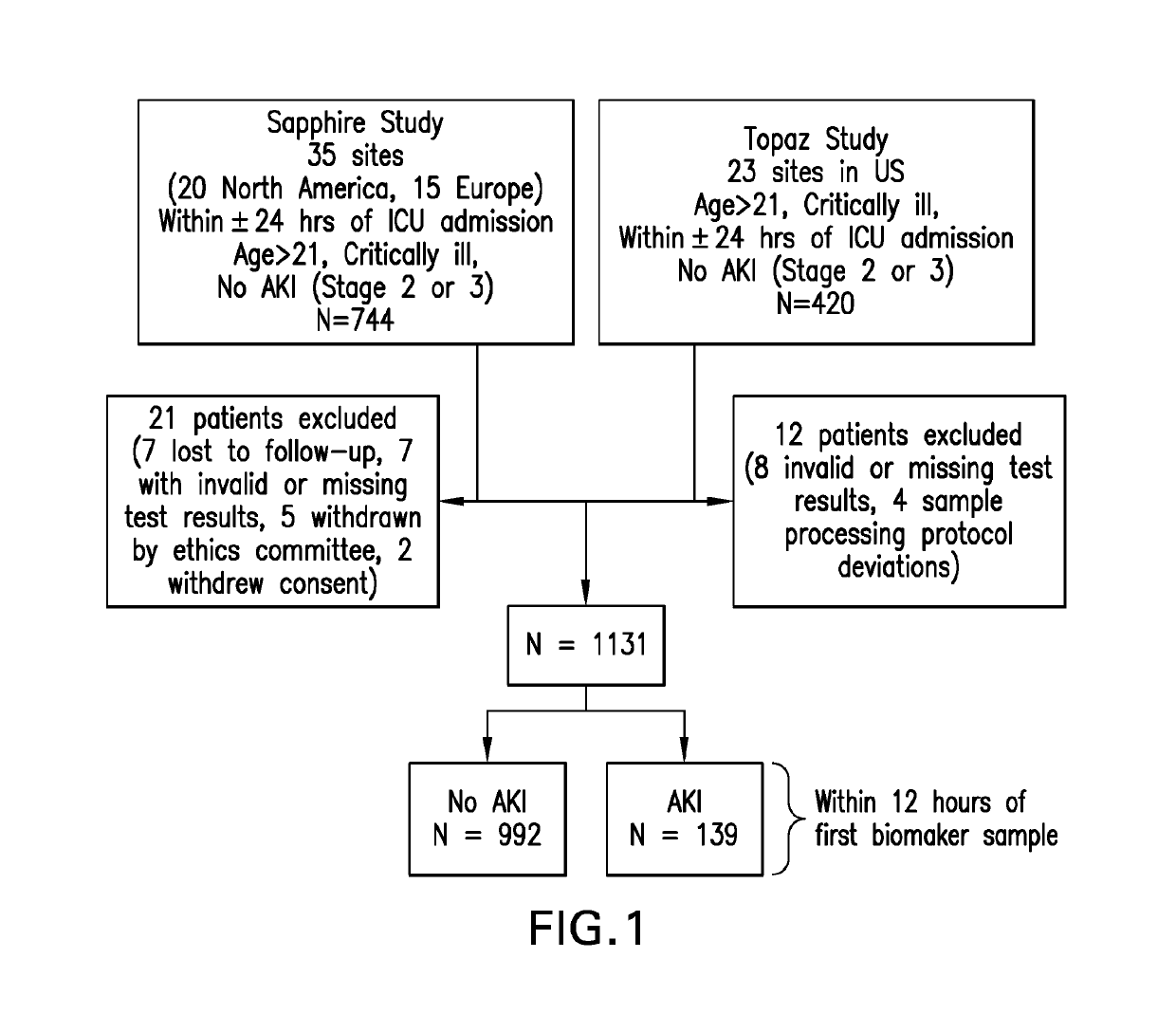Management of Acute Kidney Injury Using Insulin-Like Growth Factor-Binding Protein 7 and Tissue Inhibitor of Metalloproteinase 2
a technology of metalloproteinase and growth factor, which is applied in the field of management of acute kidney injury using insulinlike growth factor binding protein 7 and tissue inhibitor of metalloproteinase 2, can solve the problems of reducing urine output, reducing the number of hospital admissions, and affecting the quality of life of patients,
- Summary
- Abstract
- Description
- Claims
- Application Information
AI Technical Summary
Benefits of technology
Problems solved by technology
Method used
Image
Examples
example 1
ign and Participants
[0096]A secondary analysis of data collected from two multi-center clinical trials used to validate [TIMP2]•[IGFBP7] in AKI, the “Sapphire” and “Topaz” studies, was conducted. The Sapphire study enrolled 744 critically ill adult (>21 years) patients who were at risk for development of AKI. In the Topaz study, 420 critically ill adult patients were enrolled, with similar inclusion / exclusion criteria to the Sapphire study. Specifically, subjects in both studies were required to have evidence of significant pulmonary (respiratory SOFA score >2) or cardiovascular (cardiac SOFA score >1) dysfunction, and could not yet have met criteria for moderate-severe AKI (KDIGO stage 2 or 3). Patient recruitment occurred within 24 hours of intensive care unit (ICU) admission. More detailed descriptions of both studies have previously been published. Both the Sapphire and Topaz studies were approved by the Western Institutional Review Board (Olympia, Wash., USA) as well as individ...
examples 2
[0097]Clinical data collection included patient demographics, reason for ICU admission, APACHE III score variables, hourly urine output and laboratory testing results. Comorbid conditions were determined based on review of available medical records and based on diagnostic codes. Estimated GFR was determined using the CKD-EPI equation; patients with missing or unknown race were considered not to be black. Each site extracted data from clinical sources and input the data into an online electronic case-report form in a de-identified password-protected dataset. Study data was stored at an independent server site (Medidata Solutions, New York, N.Y.).
[0098]The primary outcome was moderate to severe AKI as defined by KDIGO criteria (KDIGO Clinical Practice Guideline for Acute Kidney Injury, 2012) for stage 2 or 3 AKI developing within 12 hours of enrollment. In the TOPAZ study, final determination of AKI was adjudicated by an expert panel of 3 independent nephrologists who were blinded to ...
example 3
[0099]Urine and blood samples were collected and processed using standard methods. Sample supernatants were frozen within 2 hours of collection and stored at −70° C. before batched transport to a central lab for analysis. Samples were thawed immediately before analysis. Testing for [TIMP2]•[IGFBP7] was performed using a clinical immunoassay (NEPHROCHECK Test and ASTUTE140 Meter; Astute Medical Inc., San Diego, Calif.) and lab technicians performing the testing were blinded to patient outcomes. For subjects recruited in the Sapphire study, [TIMP2]•[IGFBP7] testing was performed at Astute Medical Inc. laboratories; in the Topaz study, testing was performed in triplicate at 3 independent laboratories (University of California at San Diego, University of Louisville, and ARUP Laboratories in Salt Lake City). Test results for [TIMP2]•[IGFBP7] are uniformly reported in units of (ng / ml)2 / 1000 throughout the text.
[0100]Continuous variables were compared between AKI groups using Wilcoxon rank...
PUM
 Login to View More
Login to View More Abstract
Description
Claims
Application Information
 Login to View More
Login to View More - R&D
- Intellectual Property
- Life Sciences
- Materials
- Tech Scout
- Unparalleled Data Quality
- Higher Quality Content
- 60% Fewer Hallucinations
Browse by: Latest US Patents, China's latest patents, Technical Efficacy Thesaurus, Application Domain, Technology Topic, Popular Technical Reports.
© 2025 PatSnap. All rights reserved.Legal|Privacy policy|Modern Slavery Act Transparency Statement|Sitemap|About US| Contact US: help@patsnap.com

